1. Introduction
Bradford’s Law, one of the “three major laws” in the field of information science, explains the distribution of academic papers across journals. According to this law, if scientific journals in a given discipline are ranked in descending order by the number of papers published in that field, they can be divided into a core zone making the greatest contribution and several succeeding zones with the same number of papers. The number of journals in these zones typically follows a ratio of 1 : a : a², and so forth. Selecting academic journals that intensively cover a given field is essential to ensuring high-quality scientific research. Chinese Scientific and Technical Terminology (formerly Research on Scientific and Technical Terminology), founded in 1985, is a specialized academic journal in terminology studies under the auspices of the Chinese Academy of Sciences and sponsored by the National Committee for the Examination and Approval of Scientific and Technical Terms. It is a quarterly publication with four issues released annually. The journal aims to promote and advance research and application in terminology studies, develop a discipline with distinct Chinese characteristics, explore the principles and methods for standardizing scientific terms, facilitate the exchange of experiences in terminology standardization, and disseminate the outcomes of such work. After nearly forty years of development, it has become an important platform for publishing terminology research and application results and for facilitating scholarly exchange among experts in terminology and related disciplines both domestically and internationally.
Bibliometric analysis of journals enables researchers to comprehensively understand the current state of research and frontier developments in a specific field. Bibliometrics originated from the concept of “Statistical Bibliography” proposed by British librarian E.W. Hulme in a 1922 lecture at the University of Cambridge. Over time, this term was found to be ambiguous and inadequate for the evolving discipline. In 1969, the renowned British information scientist A. Pritchard formally proposed the term “Bibliometrics,” which has since been widely accepted in library and information science. Bibliometrics refers to the application of mathematical and statistical methods to analyze and quantify the literature of a specific field, revealing the underlying patterns and developmental trends of the discipline [1]. It is now widely used for analyzing the quantitative characteristics of journal publications, assessing journal development quality, academic information analysis and forecasting, scientific information retrieval, and research evaluation. Bibliometrics plays a crucial role in mitigating the “information crisis” and addressing fundamental contradictions in research information.
Bibliometric analysis tools include VOSviewer, Bibliometric, CiteSpace, HistCite, COOC, and others. Among them, CiteSpace is widely favored by researchers for its strong interactivity, robustness, and user-friendly interface. Developed in 2004 by Dr. Chaomei Chen at Drexel University using Java, CiteSpace offers multi-perspective, temporal, and dynamic citation visualization functions [2]. This study takes the articles published in Chinese Scientific and Technical Terminology from 2000 to 2023 as its research sample. Using the bibliometric visualization tool CiteSpace, it generates scientific knowledge maps to help researchers better understand the journal’s current status, publication characteristics, and frontier trends. The study aims to support the theoretical development and practical application of terminology studies and offers suggestions for enhancing the journal’s academic influence and dissemination.
2. Data sources and research methods
2.1. Data sources and collection
The data for this study were retrieved from the China National Knowledge Infrastructure (CNKI) full-text journal database. A precise search was conducted using Chinese Scientific and Technical Terminology and its former title Research on Scientific and Technical Terminology as the journal sources, with a time span set from 2000 to 2023. As of May 19, 2024, non-academic and non-article materials—including conference abstracts, subscription notices, calls for papers, and news reports—were excluded. After comparative filtering and manual curation, a total of 2,738 valid articles were obtained. The data were exported in both RefWorks and NoteExpress formats for subsequent analysis.
2.2. Research tools and methods
This study employs version 6.1R6 of CiteSpace as its primary research tool. CiteSpace is a citation visualization analysis software developed under the “data-intensive” research paradigm. Its most distinctive feature lies in its ability to generate intuitive knowledge maps that visually represent the current research landscape, identify research hotspots, and reveal developmental trends within a discipline [3].
3. Research status
3.1. Publication volume and trends
Publication volume refers to the total number of academic articles published in a journal within a given year [4]. It serves as an important indicator of a journal’s contribution to academic output and its capacity for information absorption and dissemination. Publication volume also largely reflects the level of academic development within the relevant discipline, while indirectly indicating the innovative and communicative abilities of researchers and the discipline’s degree of frontier engagement and vitality [5]. As such, it is an important metric for evaluating a journal’s academic standing.
Based on the extracted data, the journal’s publication volume remained relatively stable between 2000 and 2004. Starting in 2006, the volume showed significant growth, peaking in 2008 with 181 articles. From 2008 to 2011, there was a steady decline in output. Notably, the volume dropped sharply to 49 articles between 2020 and 2021. Since 2021, the publication volume has shown minor fluctuations but has generally trended toward stable development. Future publication volume is also projected to remain relatively steady. The horizontal axis in Figure 1 represents the year of publication, while the vertical axis denotes publication count.
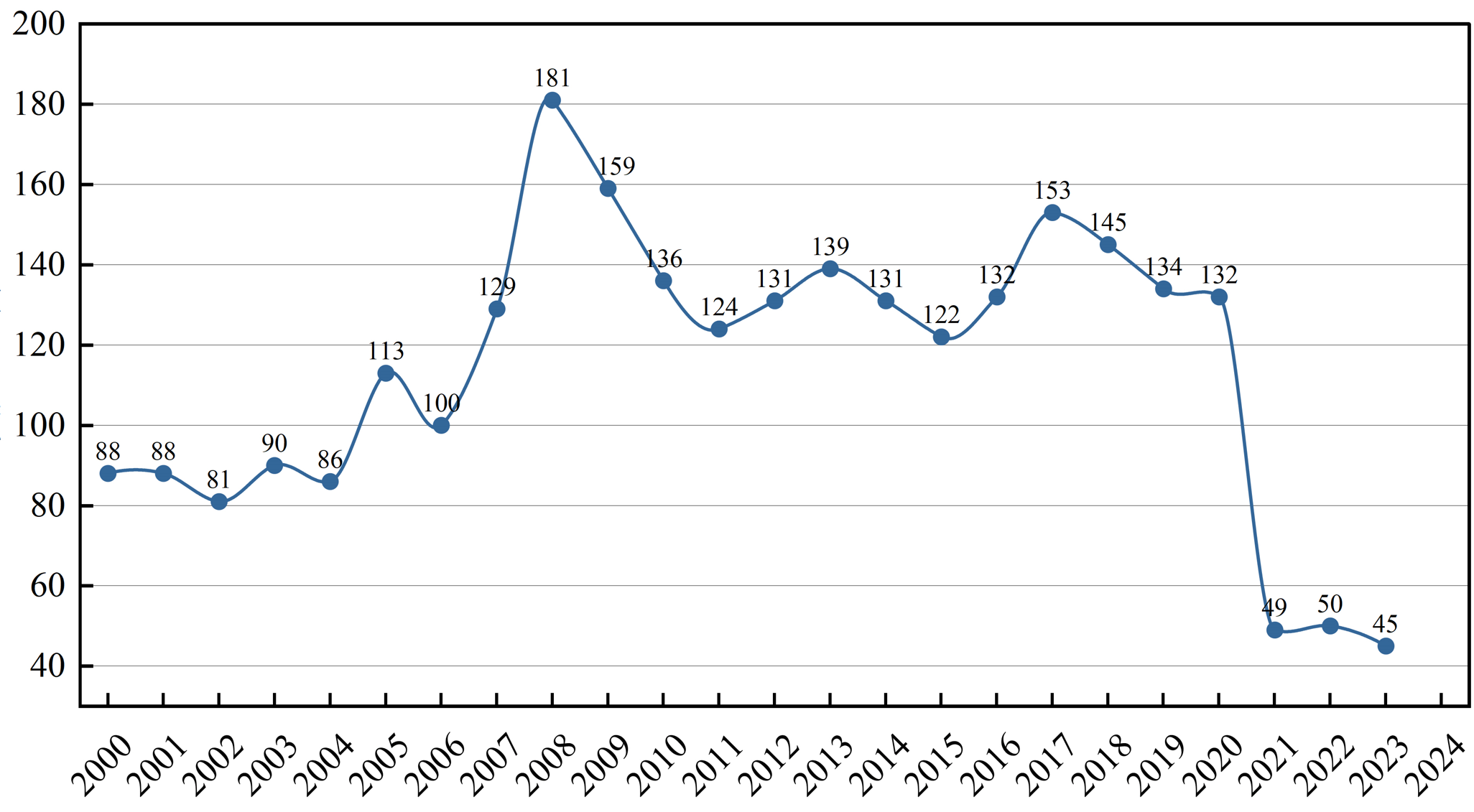
3.2. Co-citation analysis
Co-citation analysis is a common citation analysis method in bibliometrics. It is defined as the relationship whereby two documents are jointly cited by a third document; if document M cites both N1 and N2, then N1 and N2 are considered co-cited. By mapping these co-citation relationships, researchers can construct a co-citation network that visually displays the distribution of research themes within a field [6]. Based on this analysis, the top 10 most highly cited papers are presented in Table 1.
Overall, research on scientific and technical terminology has increasingly become a focus of academic attention. This trend not only reflects the rapid development of China’s science and technology sectors but also underscores the growing need for terminology research driven by frequent social and economic interactions and technological exchanges.
In terms of publication output, highly cited papers are concentrated mainly within the past decade. For example, A Brief Discussion on the Concept of “Internet+” and “Belt and Road” Needs a Language Path were both published during this period and have the highest citation counts, indicating that Chinese Scientific and Technical Terminology consistently maintains high-quality content that aligns with national strategic development needs and exhibits strong contemporary relevance.
From the perspective of research content, these highly cited papers encompass standardization and translation of terminology, including management of terminology projects, scientific and technical translation initiatives, and conceptual translation and interpretation in cultural heritage science. This diversity underscores the journal’s rich and multifaceted content, as well as the applied value of terminology work in specialized fields.
Regarding its developmental trajectory, early research in the journal predominantly focused on standardization and translation accuracy of terminology, exemplified by works such as Xu Songling’s How to Improve the Accuracy of Terminology Translation in China and Conceptual Translation and Interpretation of Terminology in Cultural Heritage Science. In recent years, Chinese Scientific and Technical Terminology has expanded its “Theoretical Research” section and strengthened its coverage of “Technical Methods” and “Practical Applications,” demonstrating an increased focus on new trends and developments in terminology research that balance cutting-edge theoretical work with practical applications.
|
Ranking |
Main content |
Author |
Publication Date |
Citation Frequency |
|
1 |
A Brief Discussion on the Connotation of “Internet +” |
Liu Jinting |
2015 |
195 |
|
2 |
Language Paves the Way for the "Belt and Road" |
Li Yuming |
2017 |
118 |
|
3 |
A Brief Discussion on Terminology Management in Practice |
Wang Huashu |
2015 |
86 |
|
4 |
Terminology Management in Scientific and Technical Translation Projects |
Wang Huashu |
2015 |
84 |
|
5 |
Translation of Scientific and Technical Terms from the Perspective of Functional Equivalence |
Guo Shulin |
2010 |
81 |
|
6 |
On Improving the Accuracy of Terminology Translation in China |
Xu Songling |
2008 |
77 |
|
7 |
Translation and Explanation of Conceptual Terms in Cultural Heritage Science |
Xu Songling |
2013 |
74 |
|
8 |
Additive Manufacturing——The Proper Name for 3D Printing |
Yu Qianfan |
2008 |
70 |
|
9 |
On the Dialectics of Terminology Standardization |
Zheng Shupu |
2010 |
66 |
|
10 |
Analysis of Language Features in Bid Documents and Translation Strategies |
Dai Guangrong |
2016 |
63 |
4. Research hotspots and trends
4.1. Keyword co-occurrence
Keyword co-occurrence analysis is commonly used to identify research hotspots and directions within a field, perform both horizontal and vertical analyses, understand the development processes and characteristics of disciplines, reveal connections between fields, and screen for representative papers [7]. The results of the co-occurrence analysis are shown in Figure 2.
The node “Terminology” had the highest frequency with 149 occurrences, followed by “Translation” with 76 occurrences, indicating that articles published in Chinese Scientific and Technical Terminology primarily focus on these two themes. Other high-frequency keywords included “terminology translation” (50), “terminology studies” (38), “standardization” (35), “English translation” (26), “scientific and technical terminology” (24), “concept” (20), “scientific terms” (17), “naming” (16), “normalization” (15), and “definition” (10).
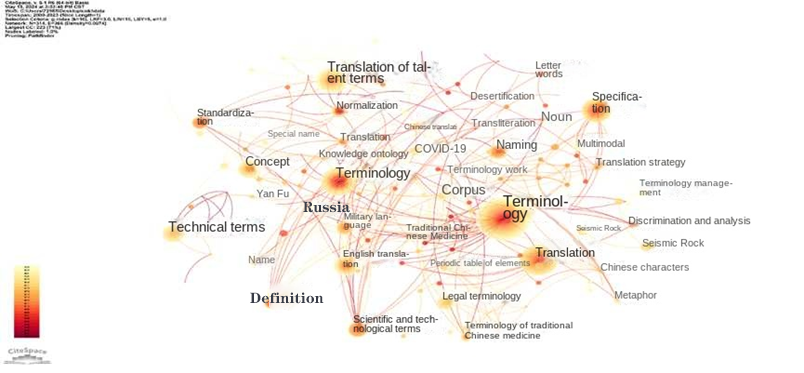
4.2. Keyword centrality
Keyword centrality measures the importance of a node within the keyword co-occurrence network. Higher centrality indicates a greater probability that a keyword co-occurs with others, reflecting the node’s significance within the overall network structure [8].
For this study, the keywords from Chinese Scientific and Technical Terminology (2000–2023) were ranked by centrality, with the top 20 listed in Table 2. Keywords with a centrality score exceeding 0.1 are generally considered key nodes. High-centrality keywords identified include “Terminology,” “Terminology Studies,” “Standardization,” “Traditional Chinese Medicine,” “Scientific Terms,” “Terminology Translation,” “Definition,” “English Translation,” and “Normalization,” representing the research hotspots over specific periods.
|
Ranking |
Centrality |
Frequency |
Keyword |
Year |
|
1 |
0.4 |
149 |
Term |
2002 |
|
2 |
0.29 |
38 |
Terminology |
2002 |
|
3 |
0.26 |
13 |
Standardization |
2003 |
|
4 |
0.22 |
8 |
Traditional Chinese Medicine |
2005 |
|
5 |
0.19 |
17 |
Scientific and Technical Terminology |
2003 |
|
6 |
0.15 |
50 |
Term Translation |
2007 |
|
7 |
0.12 |
10 |
Definition |
2008 |
|
8 |
0.11 |
26 |
English Translation |
2009 |
|
9 |
0.1 |
15 |
Regularization |
2000 |
|
10 |
0.08 |
6 |
Metaphor |
2009 |
|
11 |
0.08 |
35 |
Norm |
2007 |
|
12 |
0.07 |
9 |
Corpus |
2017 |
|
13 |
0.06 |
20 |
Concept |
2009 |
|
14 |
0.06 |
14 |
Traditional Chinese Medicine Terminology |
2005 |
|
15 |
0.05 |
16 |
Naming |
2001 |
|
16 |
0.04 |
7 |
Letter Word |
2007 |
|
17 |
0.03 |
6 |
Translation Strategy |
2010 |
|
18 |
0.03 |
13 |
Military Terminology |
2009 |
|
19 |
0.02 |
6 |
Noun |
2000 |
|
20 |
0.01 |
5 |
COVID-19 |
2020 |
4.3. Keyword clustering
To further analyze the temporal evolution of keywords in articles published in Chinese Scientific and Technical Terminology from 2000 to 2023, this study generated a keyword clustering map using CiteSpace, as shown in Figure 3. Eleven distinct clusters were identified, numbered from “#0” to “#10.”
Cluster #0 (“Scientific Terms”) focuses on topics such as scientific terminology, retrieval statistics, and scientific literature, primarily involving information retrieval and statistical analysis of scientific documents. Cluster #1 (“Scientific Terms”) centers on Chinese–English translation, Traditional Chinese Medicine (TCM) terminology, and online query system development, with a primary focus on TCM terminology translation and the construction of online query systems. Cluster #2 (“Terminology Translation”) includes themes such as terminology translation, Olympic terminology, and cognitive perspectives, emphasizing the impact of cognitive approaches on translation practices. Cluster #3 (“Ontological Shift in Terminology Work”) addresses the theoretical and practical aspects of the ontological transformation of terminology work, including terminology ontology compilation and medical English. Cluster #4 (“Terminology Knowledge Base”) concentrates on the construction and application of terminology knowledge bases, specialized corpora, and terminology data. Cluster #5 (“Conceptual Relationships”) explores conceptual relationships, cognitive processes in translation, and specialized domain knowledge, focusing on how conceptual structures influence translation. Cluster #6 (“Traditional Chinese Medicine Terminology”) involves TCM terminology, TCM corpora, and topics such as COVID-19, with emphasis on translation and corpus development in the TCM field. Cluster #7 (“Full/Half-Width Characters”) addresses issues related to scientific terms, full- and half-width characters, and terminology extraction, with a focus on standardization and extraction processes. Cluster #8 (“Terminology Extraction”) similarly centers on scientific terms, full- and half-width characters, and terminology extraction, emphasizing the standardization and extraction of terminology. Cluster #9 (“Translation Strategies”) covers translation strategies, lexical features, and animal-related vocabulary, highlighting approaches to translation and vocabulary characteristics. Cluster #10 (“Legal Terminology”) focuses on the translation of legal terminology, legal terms, and systems economics, emphasizing translation practices in the legal domain and related theoretical frameworks.
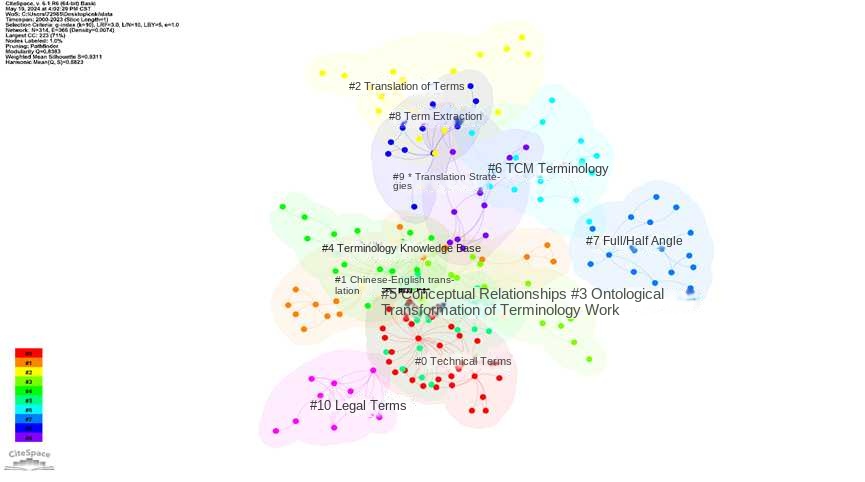
The keyword clustering map provides valuable insights into the associations among keywords and the identification of research hotspots. To further clarify the developmental trends and patterns of articles published in Chinese Scientific and Technical Terminology, this study additionally employed a “timeline view” to generate a keyword timeline map (see Figure 4). By segmenting the timeline into three-year intervals, the study excavated evolving keyword trends and examined their interrelationships, summarized as follows:
2000–2002: Research during this period primarily focused on fundamental concepts and theoretical studies of terminology. The most frequent keyword was “Terminology” (149 occurrences) in 2002. The concurrent appearance of “Terminology Studies” (38 occurrences) and “Normalization” (15 occurrences) in 2002 highlights a strong emphasis on standardization and theoretical construction within terminology research.
2003–2005: This period concentrated on the practical application of terminology in specific vertical domains. The appearance of “Scientific Terms” (17 occurrences) in 2003 and “Traditional Chinese Medicine Terminology” (14 occurrences) in 2005 reflects attention to the standardization and practical issues of terminology in specialized fields. Keywords such as “Naming” (16 occurrences, 2001) and “Definition” (10 occurrences, 2008) also underscore the importance placed on naming conventions and definitions in scientific and technical terminology research.
2006–2008: Keywords became more diversified, indicating increased attention to translation and applied contexts. For instance, “English Translation” (26 occurrences) emerged in 2009, and “Chinese Translation” (7 occurrences) in 2010, signaling the growing interest in translation issues. Additionally, “Terminology Translation” (50 occurrences, 2007) and “Translation Strategies” (6 occurrences, 2010) reveal scholarly engagement with translation practices in scientific and technical terminology.
2009–2011: The theme of “standardization and normalization of terminology” began to surface more explicitly. Keywords such as “Standardization” (13 occurrences, 2003) and “Normalization” (15 occurrences, 2000) reappeared alongside newer terms like “Terminology Management” (8 occurrences, 2019) and “Terminology Database” (5 occurrences, 2015), reflecting exploration into terminology management practices and emerging theoretical frontiers.
2012–2014: Research during this period focused on terminology in specific domains. For example, “Traditional Chinese Medicine Terminology” appeared in 2014 (3 occurrences), “Legal Terminology” in 2011 (13 occurrences), and “Terminology Knowledge Base” in 2021 (3 occurrences), highlighting the diversification of domain-specific terminology studies.
2015–2017: This period is characterized by attention to emerging technologies and innovative terminology development. Notable examples include “Periodic Table” (5 occurrences, 2016) and “COVID-19” (5 occurrences, 2020). Other keywords such as “Terminology Work” (4 occurrences, 2009) and “Knowledge Ontology” (4 occurrences, 2016) reflect growing interest in structuring and formalizing terminology knowledge.
2018–2024: More recent research emphasizes practical applications and interdisciplinary integration. Keywords such as “Seismic Rock” (5 occurrences, 2018) and “Multimodal” (4 occurrences, 2023) illustrate the breadth of subject matter, while terms like “Terminology Management” (8 occurrences, 2019) and “Terminology Knowledge Base” (2021) indicate the increasing interdisciplinary nature of terminology studies.
In summary, based on keyword frequency and temporal distribution, major thematic directions in articles published by Chinese Scientific and Technical Terminology include standardization and management of terminology, translation, terminology studies, normalization, Traditional Chinese Medicine terminology, legal terminology, military terminology, corpora, and translation strategies. Notably, in the contemporary context characterized by the rapid advancement of general-purpose artificial intelligence exemplified by ChatGPT and the dynamic evolution of “digital humanities,” terminology research is poised to embrace a vibrant landscape defined by “digital technology and AI empowerment” and “multidisciplinary development.”
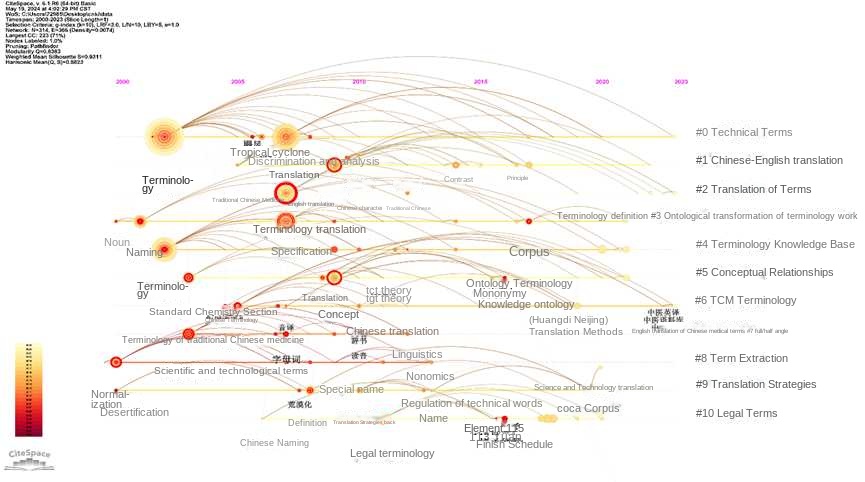
4.4. Burst keyword analysis
Burst keywords refer to those keywords that experience a sudden surge in frequency within publications during certain years, reflecting the research frontiers of a given field [9]. The CiteSpace software utilizes its built-in “Find Burst Phrases” algorithm to detect and extract such burst keywords. The top 25 burst keywords ranked by burst strength are shown in Figure 5.
In terms of burst strength, keywords such as “Scientific and Technical Terminology,” “Russia,” “Noun,” “Terminology Studies,” “Terminology Management,” “Legal Terminology,” “Yan Fu,” “Terminology Translation,” and “Corpus” all exhibit burst strengths exceeding 3. Notably, the burst strength of “Scientific and Technical Terminology” reaches 6.01, representing the frontier direction of papers published in Chinese Scientific and Technical Terminology, and to some extent, reflecting the journal’s positioning and distinctive characteristics. Regarding burst duration, “Scientific and Technical Terminology,” “Russia,” “Noun,” “Terminology Studies,” “Terminology Management,” “Legal Terminology,” and “Yan Fu” each show bursts lasting more than four years. In terms of burst periods, up to 2023, keywords such as “Terminology Management” and “Terminology Translation” continue to burst, indicating that these remain popular topics and research frontiers in the journal, attracting broad scholarly attention. It is worth noting the cooperative relationships between burst keywords within specific years. For example, “Terminology Translation” and “Corpus” both exhibited strong bursts during 2015–2017, indicating active scholarly exploration of corpus applications in terminology translation. Similarly, the concurrent bursts of “Terminology Studies” and “Terminology Management” from 2005 to 2009 reflect a related phenomenon.
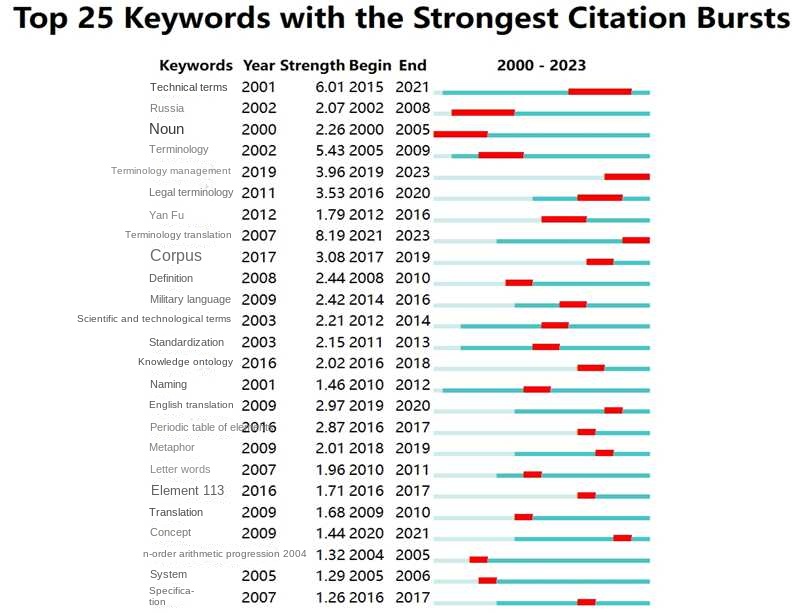
5. Research conclusion
This study applied bibliometric theories and methods, utilizing CiteSpace to conduct a visual analysis and generate a scientific knowledge map of articles published in Chinese Scientific and Technical Terminology from 2000 to 2023. Keyword co-occurrence frequency reveals the journal’s distinctive thematic focus on “terminology” research, with a particular emphasis on “terminology translation,” which forms a prominent editorial feature. The journal’s content is rich and diverse in perspective. The burst keyword analysis indicates that the journal actively promotes and showcases frontier topics in terminology research, demonstrating marked innovativeness and contemporaneity.
With the recent advancement of digitalization and internationalization in academic publishing, WeChat official accounts have become an important platform for digital publication and for catering to digital cognition needs. It is encouraging that the journal successfully launched the Chinese Scientific and Technical Terminology WeChat official account in November 2020. By establishing major sections such as “Journal Services,” “Terminology Services,” and “About Us,” the journal actively builds a digital platform connecting authors, readers, and reviewers, making positive efforts to enhance terminology knowledge services and promote standardized terminology usage awareness across society [10]. Given the current absence of specialized academic journals on terminology in English in China, it is recommended that the editorial board of Chinese Scientific and Technical Terminology and related institutions actively prepare to establish an English-language terminology journal. This would better showcase the profile of Chinese terminology scholars, facilitate the international dissemination of domestic terminology research achievements, and play a greater role in promoting exchanges and mutual learning between Chinese and foreign terminology research communities.
References
[1]. Qiu, J. (2019). Bibliometrics(2nd ed., pp. 6–10). Beijing: Science Press.
[2]. Li, J., & Chen, C. (2016). CiteSpace: Scientific text mining and visualization (2nd ed., pp. 2–6). Beijing: Capital University of Economics and Business Press.
[3]. Chen, Y., Chen, C., Liu, Z., et al. (2015). Methodological functions of CiteSpace knowledge mapping.Studies in Science of Science, 33(2), 242–253.
[4]. China Social Sciences Bibliometrics Evaluation Research Center & Tsinghua University Library. (2020).2020 China academic journal impact factor annual report (Humanities and Social Sciences edition)[J/CD]. Beijing: China Academic Journals (CD Edition) Electronic Publishing House.
[5]. Zhao, Z. (2016). Analysis of evaluation indicators for Chinese scientific journals: From the perspectives of impact factor and published article volume.Journalism Front, (22), 129–130.
[6]. Zhu, L., & Meng, X. (2013). Comparative study of bibliometrics and content analysis.Library Work and Research, (6), 64–66.
[7]. Wu, X., & Lv, N. (2012). Research on hotspot analysis methods based on keyword co-occurrence frequency.Information Theory and Practice, 35(8), 115–119.
[8]. Zhang, Y., & Wu, Y. (2022). Analysis of research hotspots and frontiers in editorial and publishing studies at home and abroad, 2015–2019.Publishing and Printing, (1), 15–23.
[9]. Chen, C. (2009). CiteSpace II: Identification and visualization of new trends and dynamics in scientific literature.Journal of Information Science, 28(3), 401–421.
[10]. China Science and Technology Terminology WeChat Service Account Launches and Publishes First Article. (2020).China Science and Technology Terminology, 22(6), 115.
Cite this article
Xuan,W. (2025). Scientific terminology studies based on bibliometrics: current status, hotspots, and trends. Advances in Humanities Research,12(4),46-54.
Data availability
The datasets used and/or analyzed during the current study will be available from the authors upon reasonable request.
Disclaimer/Publisher's Note
The statements, opinions and data contained in all publications are solely those of the individual author(s) and contributor(s) and not of EWA Publishing and/or the editor(s). EWA Publishing and/or the editor(s) disclaim responsibility for any injury to people or property resulting from any ideas, methods, instructions or products referred to in the content.
About volume
Journal:Advances in Humanities Research
© 2024 by the author(s). Licensee EWA Publishing, Oxford, UK. This article is an open access article distributed under the terms and
conditions of the Creative Commons Attribution (CC BY) license. Authors who
publish this series agree to the following terms:
1. Authors retain copyright and grant the series right of first publication with the work simultaneously licensed under a Creative Commons
Attribution License that allows others to share the work with an acknowledgment of the work's authorship and initial publication in this
series.
2. Authors are able to enter into separate, additional contractual arrangements for the non-exclusive distribution of the series's published
version of the work (e.g., post it to an institutional repository or publish it in a book), with an acknowledgment of its initial
publication in this series.
3. Authors are permitted and encouraged to post their work online (e.g., in institutional repositories or on their website) prior to and
during the submission process, as it can lead to productive exchanges, as well as earlier and greater citation of published work (See
Open access policy for details).
References
[1]. Qiu, J. (2019). Bibliometrics(2nd ed., pp. 6–10). Beijing: Science Press.
[2]. Li, J., & Chen, C. (2016). CiteSpace: Scientific text mining and visualization (2nd ed., pp. 2–6). Beijing: Capital University of Economics and Business Press.
[3]. Chen, Y., Chen, C., Liu, Z., et al. (2015). Methodological functions of CiteSpace knowledge mapping.Studies in Science of Science, 33(2), 242–253.
[4]. China Social Sciences Bibliometrics Evaluation Research Center & Tsinghua University Library. (2020).2020 China academic journal impact factor annual report (Humanities and Social Sciences edition)[J/CD]. Beijing: China Academic Journals (CD Edition) Electronic Publishing House.
[5]. Zhao, Z. (2016). Analysis of evaluation indicators for Chinese scientific journals: From the perspectives of impact factor and published article volume.Journalism Front, (22), 129–130.
[6]. Zhu, L., & Meng, X. (2013). Comparative study of bibliometrics and content analysis.Library Work and Research, (6), 64–66.
[7]. Wu, X., & Lv, N. (2012). Research on hotspot analysis methods based on keyword co-occurrence frequency.Information Theory and Practice, 35(8), 115–119.
[8]. Zhang, Y., & Wu, Y. (2022). Analysis of research hotspots and frontiers in editorial and publishing studies at home and abroad, 2015–2019.Publishing and Printing, (1), 15–23.
[9]. Chen, C. (2009). CiteSpace II: Identification and visualization of new trends and dynamics in scientific literature.Journal of Information Science, 28(3), 401–421.
[10]. China Science and Technology Terminology WeChat Service Account Launches and Publishes First Article. (2020).China Science and Technology Terminology, 22(6), 115.









